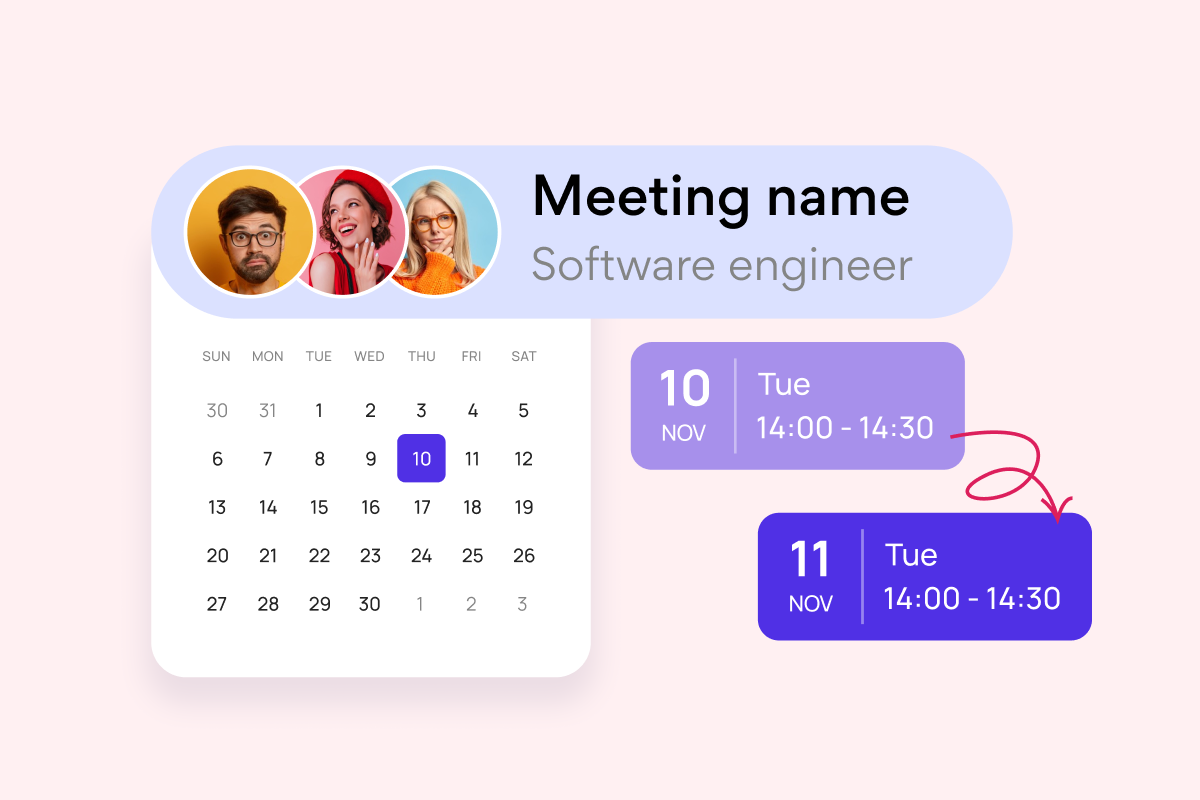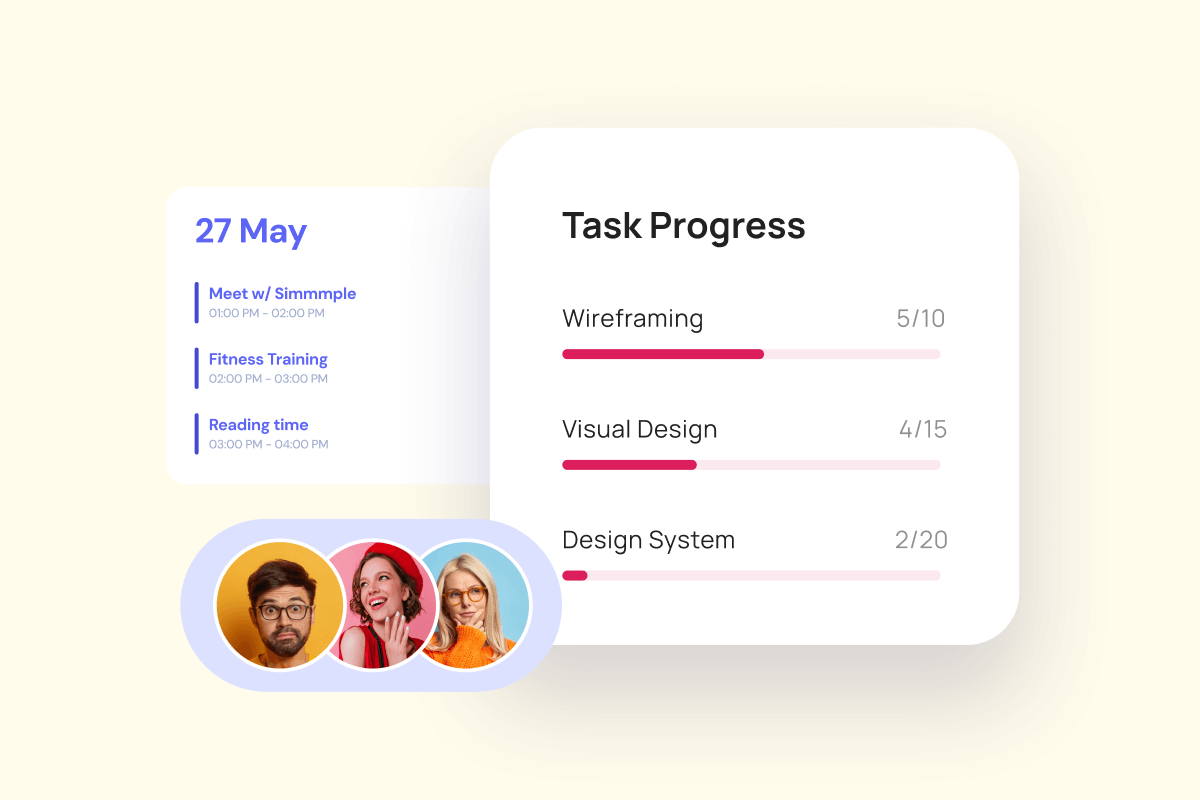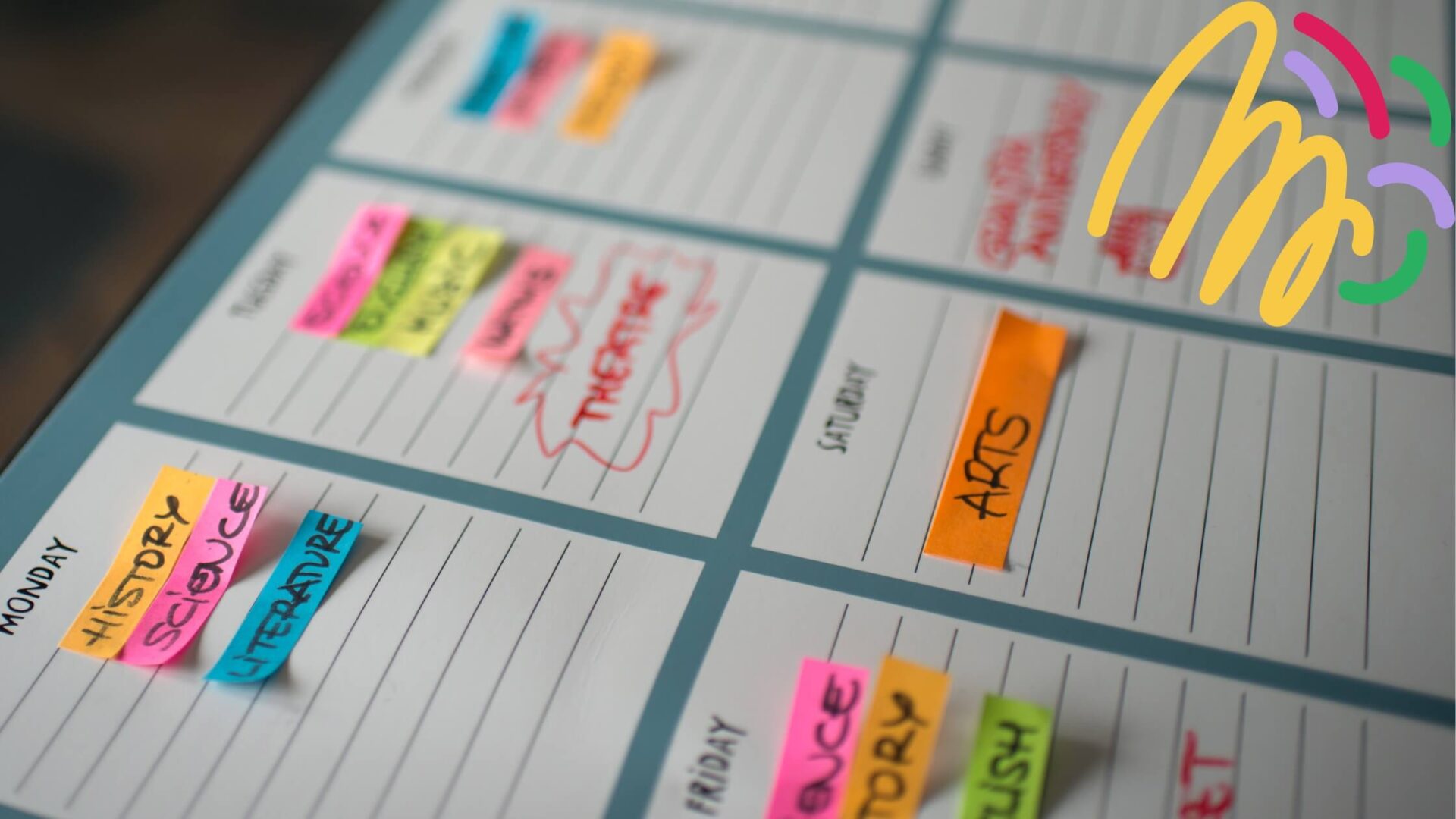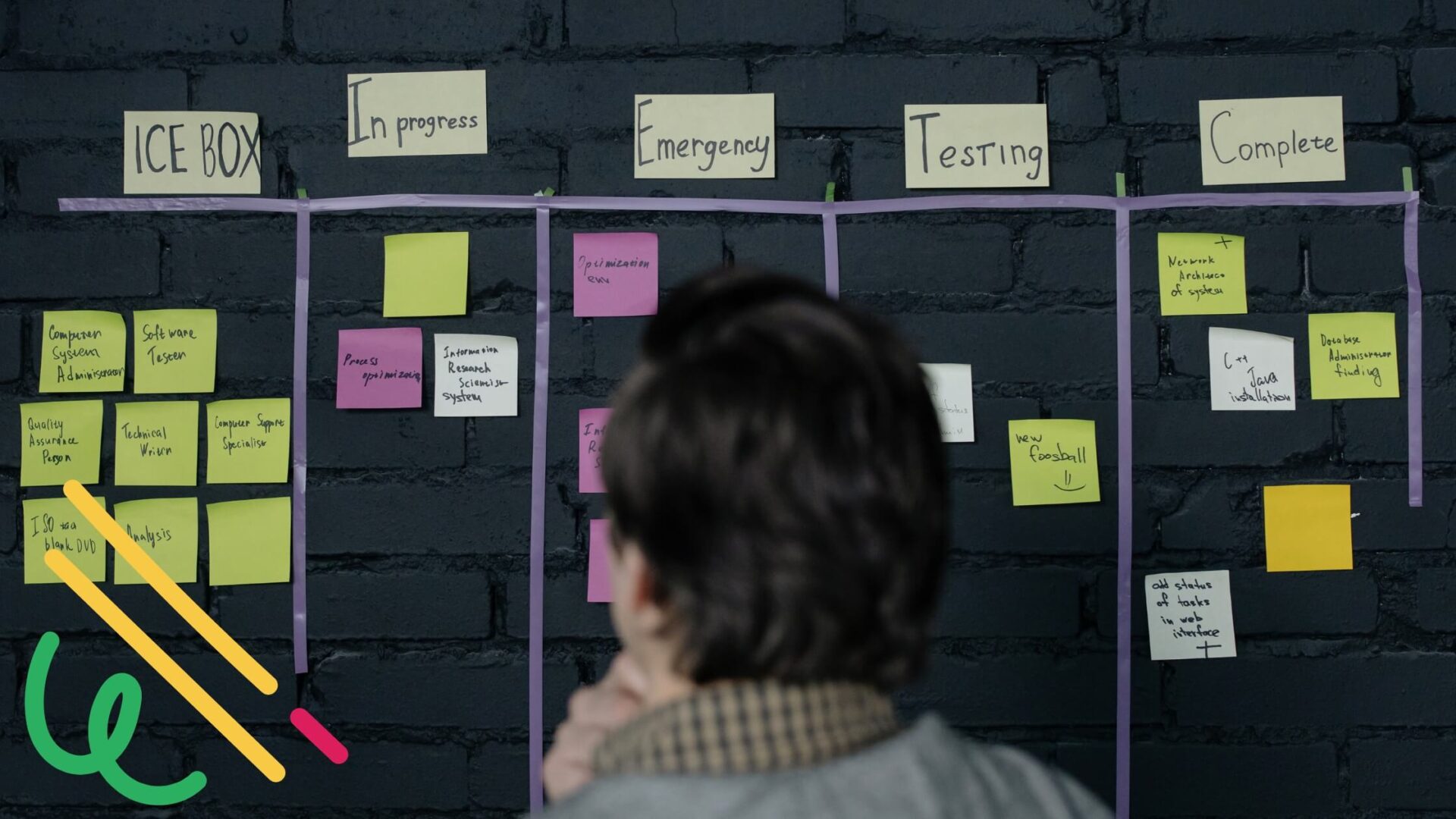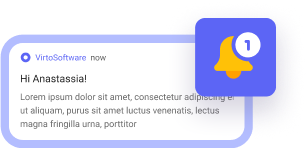Managing creative projects feels like herding cats—if cats could suddenly change their minds about color schemes, demand seventeen revisions, and insist on launching tomorrow instead of next week. Unlike traditional project management, where you can map out every deliverable with military precision, creative work thrives on iteration, inspiration, and the occasional brilliant last-minute pivot.
Think about the last time you worked on a creative campaign. Did it follow a neat, linear path from brief to delivery? Probably not. More likely, it zigzagged through multiple rounds of feedback, sparked new ideas halfway through, and required constant collaboration between designers, copywriters, and stakeholders who all had different visions of “perfect.”
This organic, sometimes chaotic nature of creative work doesn’t mean you should abandon structure altogether. Smart creative teams know that the right framework actually enhances creativity rather than constraining it. When you’re not scrambling to find the latest version of a design file or wondering whether the client approved those copy changes, you can focus on what matters most: creating something remarkable.
The challenge lies in finding that sweet spot between structure and flexibility. Traditional project management tools often feel too rigid for creative workflows, while complete freedom can lead to missed deadlines, scope creep, and frustrated team members. Creative project management bridges this gap by providing the organization you need while preserving the agility that creative work demands.
Throughout this guide, we’ll explore how to build systems that support rather than stifle creativity. You’ll discover practical strategies for managing the iterative nature of creative projects, learn how to choose tools that actually fit your team’s workflow, and understand why visualization and collaboration are non-negotiable for creative success.
What is creative project management?
Creative project management is the art of organizing chaos without killing the magic. More specifically, it’s a specialized approach to managing projects in creative industries—design, advertising, content marketing, video production, branding, and any field where the end result needs to communicate, inspire, or connect with an audience on an emotional level.
Unlike manufacturing a widget or building software with clear specifications, creative projects deal with intangibles. How do you measure “more engaging” or “brand-appropriate”? How do you schedule inspiration? Creative project management provides the framework to navigate these ambiguities while keeping teams productive and clients happy.
The primary goal isn’t just to deliver on time and within budget—though those matter. It’s to create an environment where creative minds can do their best work without drowning in administrative chaos. Think of it as building guardrails, not cages. The structure should guide the creative process, not dictate it.
Project management for creative teams serves several key purposes. First, it minimizes the organizational friction that kills momentum. When your designer doesn’t have to hunt through email chains to find the latest feedback, they can spend that time refining the concept. Second, it creates predictable processes that help teams deliver consistent quality, even when working under tight deadlines. Finally, it builds transparency that keeps everyone—from the intern to the creative director to the client—aligned on progress and expectations.
What is the difference between a project management and a creative project management?
Here’s where things get interesting. Traditional project management assumes you can define requirements upfront, estimate time accurately, and execute according to plan. Creative projects laugh in the face of such assumptions.
| Aspect | Traditional project management | Project management for creative teams |
| Iterations | Minimize revisions after approval | Multiple iterations are expected and valued |
| Requirements | Fixed, detailed specifications upfront | Abstract, evolving requirements (“make it pop”) |
| Feedback | Objective, measurable criteria | Subjective, visual, emotional responses |
| Deadlines | Rigid, immovable constraints | Flexible with strategic breathing room |
| Client involvement | Limited to key milestones | Continuous collaboration throughout |
| Change management | Changes are problems to control | Changes drive creative excellence |
| Success metrics | On-time, on-budget delivery | Quality, impact, and stakeholder satisfaction |
In classical project management, changes are problems to be controlled. Scope creep is the enemy. Multiple iterations suggest poor planning. But creative work thrives on evolution. The best campaigns often emerge from the third or fourth round of revisions, when the team finally captures something that clicks.
Multiple iterations are the norm
While traditional project managers aim for minimal revisions after approval, creative teams expect—and budget for—multiple rounds of feedback. A logo might go through ten versions before hitting the mark. A video concept could pivot completely after the first rough cut. This isn’t inefficiency; it’s how creative excellence happens.
Visual feedback rules everything
Most creative projects involve visual elements that need visual feedback. You can’t adequately critique a design layout through a text description, and video editing notes work best when time-coded to specific moments. Creative project management tools must accommodate this reality with annotation features, version control, and collaborative review systems.
Ambiguity is part of the process
Creative briefs often contain wonderfully vague requests like “make it pop” or “needs more personality.” These abstract requirements require constant interpretation and refinement throughout the project lifecycle. Traditional project management tools struggle with this fluidity, while creative-focused approaches embrace it.
Subjectivity shapes everything
Unlike engineering projects where something either works or doesn’t, creative output gets evaluated through subjective lenses. Different stakeholders may have vastly different opinions about what constitutes success. Managing these varying perspectives requires diplomatic skills and processes that capture diverse feedback without paralyzing the creative process.
Clients are creative partners
Traditional projects often keep clients at arm’s length until key milestones. Creative projects benefit from client involvement throughout the process—from initial brainstorming to final polishing. This collaborative approach requires tools and processes that make client participation productive rather than disruptive.
Priorities shift with the wind
Market conditions change. Brand strategies evolve. Inspiration strikes at inconvenient moments. Creative project management must accommodate these shifts without losing sight of core objectives. The best creative project managers become skilled at pivoting while maintaining team focus and client confidence.
Deadlines need breathing room
While traditional projects treat deadlines as immovable constraints, creative work benefits from strategic flexibility. Sometimes the best solution emerges in the final hours before a deadline. Other times, rushing to meet an arbitrary date produces mediocre results. Creative project management builds in buffers for both scenarios.
Cross-functional collaboration is essential
Creative projects rarely live in silos. A single campaign might require input from designers, copywriters, strategists, account managers, and production specialists. Each brings different perspectives, working styles, and priorities. Effective creative project management facilitates this collaboration without creating bottlenecks or communication breakdowns.
The key insight? Creative project management isn’t about imposing traditional project management principles on creative work. It’s about developing new approaches that honor how creative teams actually work while still delivering predictable results.
Creative Projects and Teams
Before diving into management strategies, it’s worth understanding what we’re actually managing. Creative projects come in countless forms, but they share common characteristics that distinguish them from other types of work. Similarly, the teams that execute these projects have unique dynamics that traditional management approaches often miss.
Creative projects
Creative projects share a common thread: they produce something designed to communicate, persuade, or emotionally connect with an audience. The deliverable might be visual, written, multimedia, or experiential, but the goal remains the same—create something that resonates.
What makes these projects unique isn’t just their creative output, but how success gets measured. Beyond meeting deadlines and staying within budget, creative projects must also achieve less tangible goals: brand alignment, emotional impact, audience engagement, and memorability. A technically perfect campaign that fails to connect with its audience is still a failure.
Consider the breadth of what counts as a creative project. A startup developing its first corporate identity faces different challenges than a video production team creating a documentary series. Yet both require similar management approaches: iterative development, visual collaboration, stakeholder alignment, and flexibility to adapt when creative direction shifts.
What is an example of a creative project?
Creative projects span numerous industries and formats. A marketing team might develop a comprehensive advertising campaign, starting with strategic positioning and evolving through copywriting, visual design, video production, and media planning. Each phase requires different specialists working toward a unified vision.
Product launches represent another common creative project type. The team must develop packaging design, promotional materials, website updates, social media content, and sales collateral—all while maintaining consistent brand messaging and visual identity across every touchpoint.
Other examples include developing animation and illustrations for educational content, creating branded documentation like annual reports or employee handbooks, designing trade show exhibits that capture attention in crowded environments, and producing social media content that builds community engagement over time.
Website redesigns blend creative and technical elements, requiring collaboration between designers, developers, content strategists, and user experience specialists. The creative challenge lies in balancing aesthetic appeal with functionality, brand expression with conversion optimization.
Even internal projects carry creative requirements. Corporate presentations, training materials, and internal communications all benefit from thoughtful design and strategic messaging. The audience might be smaller, but the need for clarity, engagement, and brand consistency remains.
Creative teams
Creative projects demand diverse skill sets working in harmony. Unlike traditional project teams with clearly defined roles and deliverables, creative teams must collaborate more fluidly, with ideas flowing between disciplines and responsibilities occasionally overlapping.
The core creative team typically includes graphic designers who translate concepts into visual reality, copywriters and editors who craft messaging that resonates with target audiences, and video producers or animators who bring motion and storytelling to the mix. Each brings specialized expertise, but the magic happens when these disciplines intersect.
Marketers and strategists provide the foundation by defining objectives, identifying target audiences, and determining success metrics. They ensure creative output aligns with business goals rather than existing purely for aesthetic purposes. Project managers coordinate these moving parts, managing timelines, facilitating communication, and keeping everyone focused on shared objectives.
Many creative projects also involve technical specialists. Web developers implement digital designs, photographers capture original imagery, and audio engineers ensure video content sounds professional. Depending on project scope, you might also need motion graphics specialists, user experience researchers, or brand strategists.
External contributors frequently join the mix. Freelance illustrators bring specialized skills for specific projects. Voice actors, musicians, and production crews contribute to video content. Printing specialists ensure physical materials meet quality standards. Managing these external relationships requires additional coordination and communication.
The challenge intensifies when you consider how these team members work differently. Designers think visually and may struggle to articulate concepts through words alone. Copywriters craft messages that work in isolation but must integrate with visual elements they can’t always envision. Video producers consider pacing, music, and transitions that other team members might overlook.
Client teams add another layer of complexity. Brand managers, marketing directors, and C-suite executives all have opinions about creative direction. Each brings valuable perspective, but their feedback must be filtered and synthesized to avoid creative paralysis. The account manager or project lead becomes crucial in translating business objectives into creative direction and creative concepts into business impact.
This combination of diverse skills, subjective decision-making, and multiple stakeholders makes creative project management uniquely challenging. Success depends not just on individual talent, but on creating systems that help talented people work together effectively. The best creative project managers become skilled at facilitating collaboration while protecting the creative process from unnecessary interference.
Why Creative Teams Need Project Management
Ask any creative professional about project management, and you’ll likely get mixed reactions. Some see it as essential scaffolding that supports their best work. Others view it as corporate red tape that kills the creative spirit. The truth lies somewhere in between—and understanding that nuance makes all the difference.
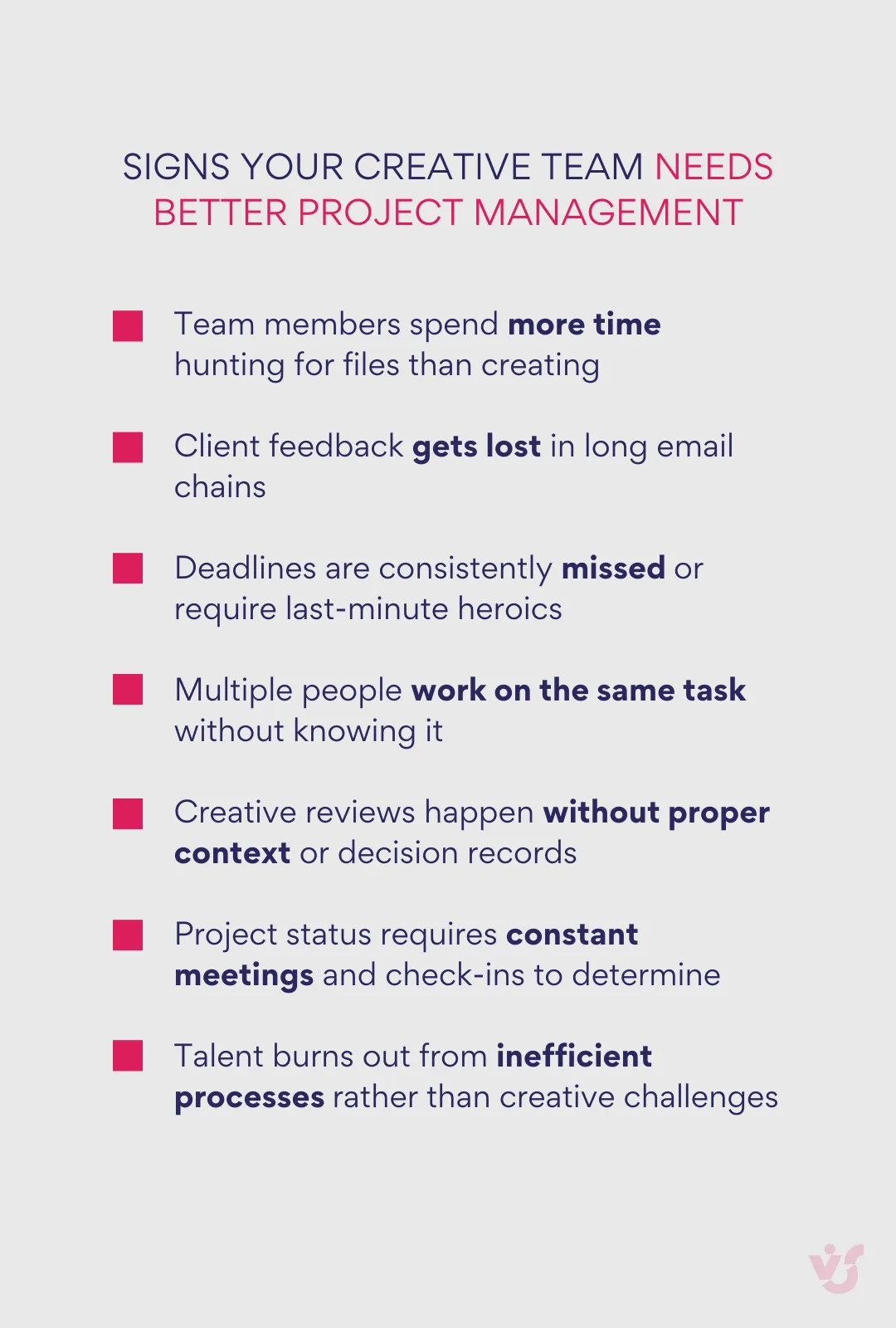
Is project management good for creatives?
The short answer is yes—but only when it’s done right. Many creative professionals initially resist project management, viewing it as bureaucratic overhead that stifles spontaneity. They’re not entirely wrong. Traditional project management can feel like forcing a jazz musician to play from sheet music when they’d rather improvise.
However, the right approach to project management actually amplifies creativity rather than constraining it. Think of it as providing a stage for improvisation rather than a script to follow. When creative teams don’t have to worry about logistical chaos, they can focus their energy on what they do best: creating remarkable work.
Consider what happens in creative environments without proper project management. Deadlines become moving targets. Team members duplicate efforts or work at cross-purposes. Feedback gets lost in email chains. Clients grow frustrated with lack of visibility into progress. The most talented designers spend their time hunting for files instead of designing. Writers get interrupted constantly with status updates instead of writing.
This organizational chaos doesn’t just waste time—it actively damages creative output. Creativity requires sustained focus, and constant interruptions fragment attention. Good ideas get abandoned when they can’t be properly documented and developed. Team members burn out from working inefficiently rather than working smart.
👉So, what is project management in creative industries? Project management creative industries is a specialized approach to organizing and coordinating creative work like design, advertising, content creation, and marketing campaigns. Unlike traditional project management that focuses on rigid timelines and fixed requirements, creative project management embraces iteration, subjective feedback, and flexible workflows that support the inherently collaborative and evolving nature of creative work. It provides structure and transparency while preserving the creative freedom teams need to produce innovative, high-quality output that connects with audiences.
How project management for creative projects help teams
Project management helps creative teams in several crucial ways:
- Frees up time for creativity. When routine tasks get automated and planning becomes systematic, designers and copywriters can focus on what they were hired to do. Instead of spending an hour each morning figuring out what to work on, they can dive straight into creative problem-solving. Clear processes eliminate the mental overhead of constantly making organizational decisions.
- Simplifies task setting and tracking. Every team member knows exactly what they need to deliver, when it’s due, and how their work connects to the bigger picture. This clarity eliminates the anxiety of wondering whether you’re working on the right thing. It also prevents the frustration of completing work that gets scrapped because priorities shifted without notice.
- Enables smart prioritization and deadline management. Creative projects often develop non-linearly, with breakthrough moments that change everything. Good project management provides the flexibility to restructure schedules when inspiration strikes while maintaining control over critical milestones. You can adapt the plan without abandoning the plan entirely.
- Creates process transparency. Everyone can see who’s doing what, which tasks are progressing smoothly, and where bottlenecks might emerge. This visibility helps team members support each other proactively rather than reactively. It also helps clients understand why certain phases take time, reducing pressure for unrealistic speed.
- Reduces re-approvals and endless edits. Structured communication and stage-by-stage approval processes minimize misunderstandings between team members and stakeholders. When everyone agrees on direction before diving into execution, you spend less time backtracking and more time moving forward. Clear feedback loops also prevent the dreaded “death by a thousand cuts” scenario where small changes accumulate into major revisions.
- Improves communication and feedback quality. Project management platforms centralize discussions, making it easy to find previous decisions and understand the reasoning behind creative choices. Comments stay attached to specific tasks or assets, preventing important feedback from getting buried in email threads. Team members can collaborate asynchronously without losing context.
The key insight here is that project management should feel invisible to the creative process. When it’s working well, team members don’t think about the system—they just use it naturally. The best creative project management disappears into the background, providing structure without creating friction.
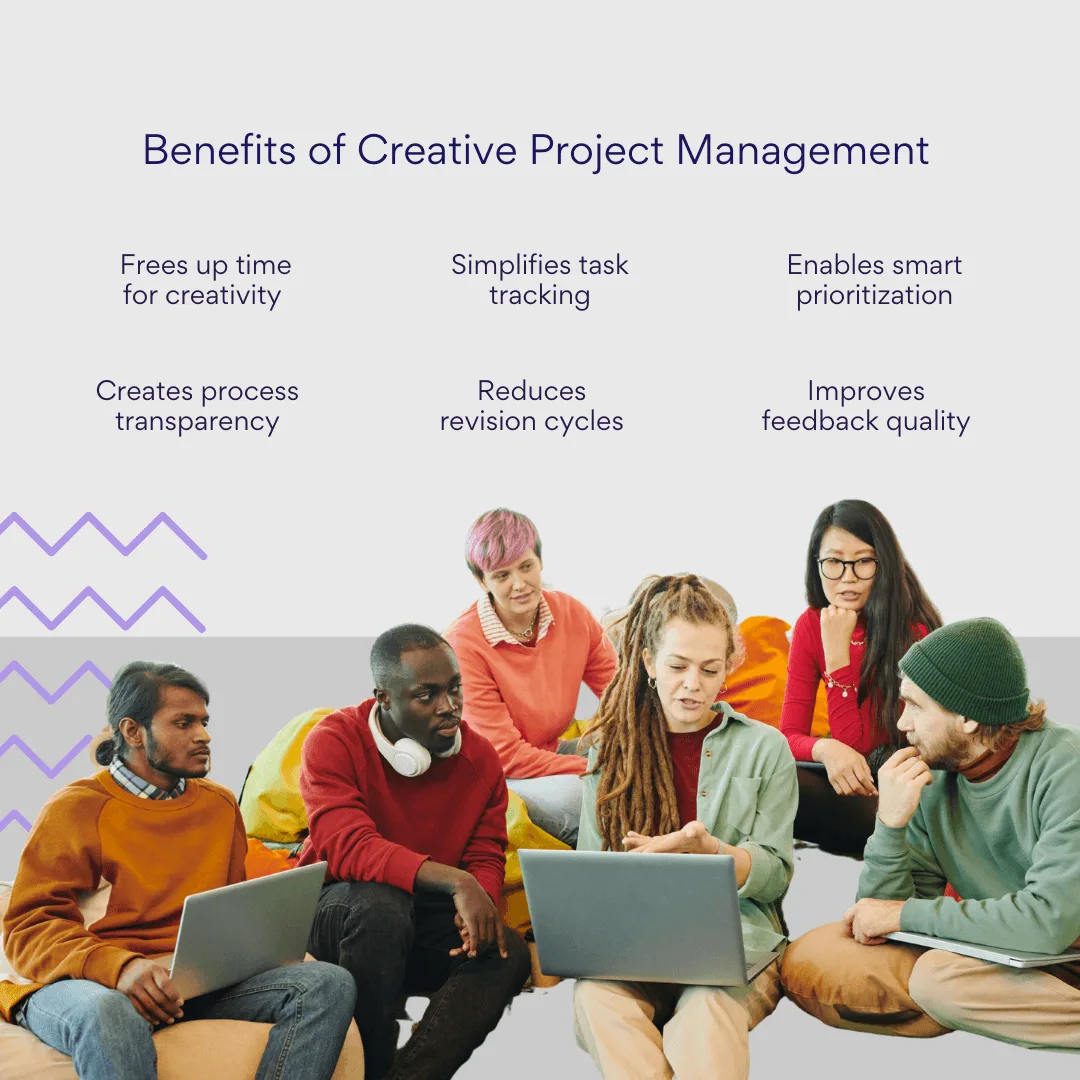
Creative teams that embrace thoughtful project management often discover they’re more creative, not less. They can take bigger risks because they have systems to recover from failures. They can explore more ideas because they’re not bogged down in administrative tasks. They can collaborate more effectively because communication flows smoothly.
The goal isn’t to eliminate spontaneity or control every aspect of creative work. It’s to create an environment where spontaneity can flourish within a framework that keeps projects moving toward successful completion. When creative teams get this balance right, they achieve something remarkable: predictable creativity.
Stages and Strategies for Managing Project Management for Creatives
Unlike the linear progression you might find in software development or construction, creative projects follow a more fluid path. Ideas evolve, concepts pivot, and the best solutions often emerge through iteration rather than initial planning. Yet even in this dynamic environment, having a structured approach prevents chaos from overwhelming creativity.
The key is building flexibility into your framework. Instead of rigid gates that must be passed in sequence, think of these stages as guideposts that help teams navigate toward their destination while leaving room for creative detours along the way.
The creative project lifecycle
While every creative project is unique, most follow a recognizable rhythm from initial spark to final delivery. Understanding these natural phases helps teams plan resources, set expectations, and build workflows that support rather than fight the creative process.
| Stage | Primary activities | Key deliverables | Typical duration |
| Idea & concept | Brainstorming, mood boards, research | Creative brief, concept direction | 1-2 weeks |
| Goal setting | Objective definition, task breakdown | Project plan, success metrics | 3-5 days |
| Role distribution | Team assembly, responsibility mapping | RACI matrix, communication plan | 1-2 days |
| Creative development | Design, writing, iteration | Draft concepts, initial executions | 2-6 weeks |
| Review & coordination | Feedback cycles, stakeholder alignment | Approved concepts, revision notes | 1-3 weeks |
| Final refinement | Polish, technical prep, quality check | Production-ready assets | 3-7 days |
| Launch & release | Deployment, media coordination | Live campaign, published content | 1-5 days |
| Results analysis | Performance review, learning capture | Analytics report, process improvements | 1-2 weeks |
Idea and concept development
Every creative project begins with a spark—sometimes a clear brief from a client, other times a vague notion that needs shape and definition. This initial phase involves brainstorming sessions, mood board creation, competitive research, and reference gathering. Teams explore possibilities without commitment, letting ideas collide and combine.
The goal isn’t to find the perfect solution immediately, but to expand the universe of possibilities before narrowing focus. Smart teams resist the urge to jump into execution mode too quickly. Spending extra time in concept development often saves weeks of revisions later.
Goal setting and objective definition
Once the creative direction starts to crystallize, teams must translate inspiration into measurable outcomes. What does success look like for this project? How will you know when you’ve achieved it? These questions force creative teams to think beyond aesthetic preferences toward business impact.
This stage involves decomposing big visions into manageable tasks. A complete brand identity project might break down into logo design, color palette development, typography selection, application guidelines, and template creation. Each component needs its own timeline and success criteria while contributing to the overall creative vision.
Role distribution and responsibility mapping
With clear objectives established, teams can assign responsibilities based on individual strengths and project requirements. Who leads visual concept development? Who handles client communication? Who ensures technical feasibility? Clear role definition prevents overlap and ensures nothing falls through the cracks.
This isn’t about rigid job descriptions—creative projects often require fluid collaboration. Instead, it’s about establishing primary accountability for different project aspects while encouraging cross-functional input and support.
Creative development and iteration
Here’s where the magic happens, but also where traditional project management often breaks down. Creative development rarely follows a straight line from concept to completion. Ideas evolve, new possibilities emerge, and the team’s understanding of the challenge deepens through the work itself.
Successful creative project management accommodates this iterative nature without abandoning structure entirely. Teams might work in creative sprints, developing concepts to specific milestone points before gathering feedback and adjusting direction. The key is maintaining momentum while staying open to creative evolution.
Review and coordination cycles
Creative work requires constant feedback, but unstructured feedback can derail projects. Effective review cycles balance thorough evaluation with forward progress. Teams might establish regular review points—weekly creative reviews, client check-ins at 25% and 75% completion, or approval gates before major production phases.
The challenge lies in managing subjective feedback from multiple stakeholders without losing creative coherence. Clear feedback protocols help teams capture input systematically while maintaining creative leadership over final decisions.
Final refinement and polish
As projects near completion, focus shifts from concept development to execution excellence. Details matter more. Colors get fine-tuned, copy gets polished, and technical specifications get locked down. This phase requires different skills and mindset than earlier creative exploration.
Teams must resist the temptation to introduce major changes during refinement phases. New ideas should be captured for future projects rather than derailing current completion timelines.
Launch and release execution
Creative projects don’t end when the final design gets approved—they culminate in successful deployment. Whether launching a marketing campaign, publishing content, or unveiling a new brand identity, execution requires its own planning and coordination.
This phase often involves technical implementation, media coordination, stakeholder training, and launch sequence management. Creative teams must work closely with operational teams to ensure smooth deployment of their creative work.
Results analysis and learning capture
The best creative teams don’t just ship projects—they learn from them. Post-launch analysis reveals what resonated with audiences, what could be improved, and what insights apply to future projects. This feedback loop strengthens both creative instincts and project management approaches over time.
Effective strategies for creative workflows
Knowing the project lifecycle is one thing—executing it smoothly is another. These proven strategies help creative teams maintain momentum while preserving the flexibility that great creative work demands.
Embracing agile with creative sprints
Short development cycles work particularly well for creative projects because they provide natural break points for evaluation and course correction. Two-week sprints allow teams to explore concepts thoroughly without getting too attached to directions that might not work.
Sprint approaches prove especially valuable for digital campaigns, content creation, and iterative design work. Teams can test ideas quickly, gather feedback, and adapt their approach based on real results rather than theoretical planning.
Visual control through kanban methodology
Kanban boards offer intuitive project tracking that matches how creative minds work. Tasks move visually through stages—from concept to development to review to approval. Team members can see project status at a glance without digging through complicated reports.
The visual nature of kanban particularly suits creative agencies and studios where multiple projects run simultaneously. Designers can quickly see which tasks need attention, what’s waiting for feedback, and where bottlenecks might be forming.
Campaign sprint approaches
Large creative initiatives benefit from sprint-based organization that breaks overwhelming projects into manageable phases. A comprehensive advertising campaign might include discovery sprints, concept development sprints, production sprints, and launch sprints—each with specific deliverables and success criteria.
This approach helps teams maintain momentum while allowing for strategic pivots between phases. It also provides natural checkpoints for client alignment and resource reallocation.
Template-driven efficiency
Recurring project types—banner creation, email campaigns, social media content—benefit from standardized templates and workflows. Templates don’t constrain creativity; they eliminate decision fatigue around process so creative energy can focus on content and concept.
Smart teams develop template libraries that capture their best practices while remaining flexible enough for customization. This systematic approach to routine work creates more time and mental space for high-impact creative challenges.
The most successful creative project management strategies recognize that creativity and structure aren’t opposing forces—they’re complementary elements that strengthen each other when properly balanced. The right framework supports creative exploration while ensuring projects reach successful completion on time and within scope.
Choosing Software for Creative Team Project Management
Traditional project management tools often feel like trying to paint with a spreadsheet—technically possible, but missing the point entirely. Creative work demands software that thinks like creative people: visually, flexibly, and collaboratively. The best tools disappear into your workflow rather than forcing you to adapt your process to rigid software constraints.
Unlike classic project management platforms built for predictable workflows and measurable outputs, creative project management software must accommodate ambiguity, iteration, and subjective feedback. These tools prioritize visual communication over detailed reports, flexible collaboration over strict hierarchies, and intuitive interfaces over comprehensive feature sets.
Essential features for creative workflows
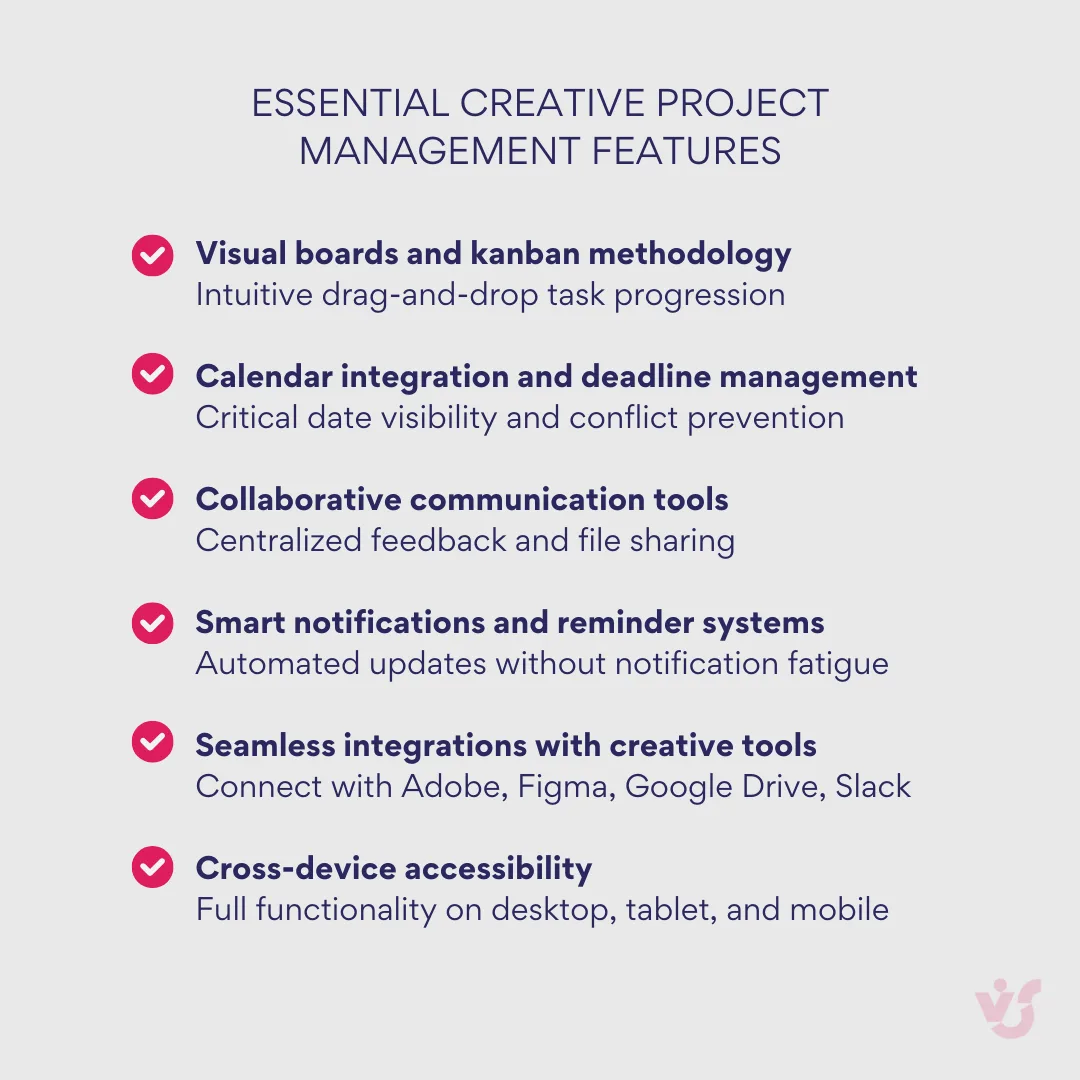
Here’s how modern solutions support the unique needs of creative workflows:
Visual boards and kanban methodology
Creative minds think in pictures, not lists. Kanban boards with columns and cards provide an intuitive way to track task progression through stages like “brainstorming,” “in progress,” “client review,” “revisions needed,” and “approved for production.” This visual approach feels natural even to team members who typically avoid traditional project management tools.
The beauty of kanban lies in its simplicity. Anyone can understand the system within minutes, and the drag-and-drop functionality matches how creative professionals naturally organize their work. When a designer moves a logo concept from “initial draft” to “client review,” the entire team instantly sees the progress without needing status meetings or email updates.
Calendar integration and deadline management
Creative projects live and die by deadlines—campaign launches, publication schedules, event dates that can’t be moved. The ability to visualize upcoming deadlines alongside current workload helps teams prioritize effectively and spot potential conflicts before they become crises.
Smart calendar features go beyond simple due dates. They show dependencies between tasks, highlight critical path items, and provide early warning when deadlines might be at risk. This visibility proves especially valuable when managing multiple campaigns simultaneously or coordinating launches across different channels.
Collaborative communication tools
Creative work thrives on feedback, but scattered communication kills projects. The best creative project management tools centralize discussions around specific tasks and assets. Instead of hunting through email threads to find that crucial client comment about color preferences, everything stays attached to the relevant task or file.
Look for tools that support file attachments, visual annotations, @mentions for team members, and threaded conversations. The ability to comment directly on design mockups or video timestamps transforms feedback from abstract suggestions into actionable direction.
Smart notifications and reminder systems
Creative professionals juggle multiple projects, each with its own cast of stakeholders and deadlines. Automated reminders help maintain focus without constant manual tracking. The system should notify relevant team members when tasks are assigned, deadlines approach, or feedback is provided.
However, notification systems must be intelligent rather than overwhelming. The best tools allow customization so team members receive relevant updates without notification fatigue that leads to ignoring important messages.
Seamless integrations with creative tools
Creative teams already use specialized software for their core work—Adobe Creative Cloud, Figma, Sketch, Canva, or industry-specific applications. Project management tools should integrate with these existing workflows rather than replacing them.
Strong integration capabilities include connecting with cloud storage services like Google Drive and Dropbox, communication platforms like Slack and Microsoft Teams, and design tools for seamless file sharing and version control. The goal is creating a unified ecosystem where information flows naturally between tools.
Cross-device accessibility
Creative work doesn’t happen only at desks. Inspiration strikes during commutes, client meetings occur in coffee shops, and approvals are needed during weekend events. Project management tools must work seamlessly across computers, tablets, and smartphones without losing functionality.
Mobile accessibility proves especially important for client approval workflows. When a creative director can review and approve concepts from their phone, projects move faster and teams stay unblocked.
Popular tools for creative team project management
A variety of project management platforms cater to the unique needs of creative teams, each offering distinct features and workflows. Below are some of the most popular tools and how they address the challenges of creative collaboration:
Trello: Visual simplicity for small teams
Trello built its reputation on making kanban boards accessible to everyone. The interface feels immediately familiar—like a digital version of sticky notes on a whiteboard. Cards can include checklists, due dates, attachments, and color-coded labels that help teams organize work visually.
The platform excels for small creative teams, marketing agencies, and freelancers who need straightforward task tracking without overwhelming complexity. Butler automation features help streamline repetitive tasks, while workspace views provide calendar and timeline perspectives when needed.
Trello works best for teams that value simplicity over advanced features. While it may lack the depth needed for complex multi-phase projects, its ease of use means team adoption happens quickly with minimal training required.
Notion: All-in-one flexibility for content teams
Notion blends project management with documentation, making it ideal for creative teams that need to manage tasks alongside content libraries, brand guidelines, and project archives. The block-based interface allows teams to create custom project pages that combine kanban boards, calendars, databases, and rich text documentation.
Recent AI enhancements help with content creation, task automation, and project summaries, while collaborative editing features support real-time teamwork. The platform particularly suits content marketing teams, design agencies, and creative departments that need a single source of truth for both active projects and organizational knowledge.
Notion’s flexibility can be overwhelming initially, but teams that invest time in setup often find it becomes indispensable for managing both creative projects and creative resources.
Asana: Structured collaboration for distributed teams
Asana strikes a balance between visual simplicity and project management depth. Teams can view work through lists, boards, timeline, or calendar views depending on their needs. Strong automation features help reduce manual task management, while portfolio views provide oversight for managers juggling multiple projects.
The platform excels for remote creative teams that need clear task assignment, progress tracking, and deadline management. Built-in messaging, file sharing, and @mention capabilities keep communication organized, while mobile apps ensure team members stay connected regardless of location.
Asana works particularly well for creative teams with established processes who want to maintain flexibility while ensuring nothing falls through the cracks.
Monday.com: Customizable dashboards for agencies
Monday.com provides highly visual, customizable project management with strong automation capabilities. Teams can create custom workflows, build dashboards with relevant metrics, and use templates for recurring project types. The platform adapts to various creative workflows rather than forcing teams into predefined structures.
AI features help with project summaries and task suggestions, while extensive integration options connect with most creative tools. The visual interface makes project status immediately clear to stakeholders, reducing status meeting frequency and email check-ins.
This platform suits creative agencies and larger creative teams that need scalable project management without sacrificing visual appeal or ease of use.
ClickUp: Feature-rich flexibility for growing teams
ClickUp offers an impressive array of features on a generous free plan, making it attractive for startups and freelancers testing project management approaches. The platform includes 15+ view options, collaborative tools like whiteboards and documents, and hierarchical organization that scales from simple task lists to complex project structures.
Recent AI enhancements assist with task creation, project summaries, and content generation. The platform works well for creative teams that want room to grow without switching tools as their needs evolve.
ClickUp’s feature richness can feel overwhelming initially, but its flexibility allows teams to start simple and gradually adopt more advanced capabilities as their project management maturity develops.
VirtoSoftware Apps: Seamless Microsoft Teams integration
For creative teams already working within the Microsoft 365 ecosystem, Virto Kanban Board and Virto Calendar apps provide natural workflow extensions without requiring separate tool adoption. These apps add visual project management directly within Teams channels, maintaining context and communication flow.
Virto Kanban Board offers customizable task visualization with drag-and-drop functionality, while Virto Calendar consolidates scheduling across multiple projects and team members. Both tools integrate seamlessly with existing Microsoft workflows, reducing tool switching and maintaining unified communication.
These solutions work particularly well for creative teams in larger organizations where Microsoft 365 is the standard collaboration platform, or for teams that prefer working within a single integrated environment.
| Tool | Best for | Key strength | Free plan | Starting price |
| Trello | Small teams, freelancers | Visual simplicity | Yes (10 boards) | $5/user/month |
| Notion | Content teams, documentation | All-in-one flexibility | Yes (individuals) | $8/user/month |
| Asana | Remote teams, structured workflows | Collaboration features | Yes (15 users) | $10.99/user/month |
| Monday.com | Agencies, automation needs | Customizable dashboards | Yes (2 users) | $9/user/month |
| ClickUp | Startups, growing teams | Feature-rich free plan | Yes (unlimited users) | $7/user/month |
| VirtoSoftware Apps | Microsoft 365 teams | Seamless Teams integration | Trial available | Contact for pricing |
Making the right choice for creative projects management tool
Software selection should align with team size, project complexity, and existing workflows rather than being driven by feature checklists or pricing alone. Small creative teams might thrive with Trello’s simplicity, while large agencies might need Monday.com’s customization capabilities or Asana’s structured approach.
The best approach involves testing multiple options with real projects before committing. Most platforms offer free trials or plans that allow teams to experience how the software fits their actual work patterns. Pay attention to adoption rates—the most feature-rich tool becomes useless if team members won’t use it consistently.
Look for tools that enhance your creative process rather than replacing it. The right project management software should feel like a natural extension of how your team already works, providing structure and visibility without constraining creative exploration or collaborative spontaneity.
VirtoSoftware Tools for Creative Project Management
Creative agencies, studios, marketing departments, and content teams increasingly find themselves working within the Microsoft 365 ecosystem. Microsoft Teams has become the central hub for collaboration, file sharing, and communication. For these teams, switching between multiple external tools creates friction that disrupts creative flow and fragments communication.
VirtoSoftware products offer a natural solution by extending project management functionality directly within the familiar Microsoft environment. Instead of forcing teams to adopt yet another platform, VirtoSoftware tools integrate seamlessly with Teams and SharePoint, maintaining context and preserving existing workflows while adding powerful visual project management capabilities.
These solutions enable creative teams to manage projects flexibly and visually without unnecessary complexity. Teams can maintain control over tasks, deadlines, and communication while staying within the ecosystem they already know and use daily. This integration eliminates the context switching that often disrupts creative thinking and collaborative momentum.
Explore VirtoSoftware apps for creative Project Management
Virto Kanban Board App: Visual task management within Teams

The Virto Kanban Board App brings full-featured kanban functionality directly into Microsoft Teams workspaces, specifically designed with creative team needs in mind. This isn’t a simplified add-on—it’s a comprehensive task management solution that lives within your existing collaboration environment.
Creative agencies, design studios, content marketing teams, video production groups, and internal marketing departments can immediately benefit from this integrated approach. The tool understands that creative work requires flexibility, visual clarity, and constant collaboration—all while maintaining professional project oversight.
Visual task management that matches creative thinking
Each task appears as a customizable card that can include detailed descriptions, deadlines, comments, file attachments, color-coded tags, and team member assignments. This visual approach mirrors how creative professionals naturally organize ideas—moving concepts through development stages in a way that’s immediately understandable to everyone involved.
The drag-and-drop functionality feels intuitive for creative minds accustomed to working with visual layouts and design elements. Moving a logo concept from “initial draft” to “client review” to “final approval” requires nothing more than dragging the card across columns, instantly updating the entire team on progress.
Flexible workflows for creative processes
Creative projects rarely follow identical paths, and the Virto Kanban Board accommodates this reality through completely customizable column structures. Teams can create pipelines that match their specific creative processes—whether that’s “idea → concept → draft → review → revisions → approval → production → launch” for marketing campaigns or “brief → research → wireframe → design → feedback → refinement → delivery” for design projects.
Template options provide starting points for common creative workflows while allowing full customization as teams discover what works best for their specific processes. Color labels, priority indicators, and custom fields help teams organize work according to client, project type, urgency, or any other categorization system that supports their workflow.
Seamless Teams integration for natural collaboration
The app integrates directly into Microsoft Teams channels as a tab, eliminating the need for external tool registration or separate logins. Team members can discuss projects in Teams chat while simultaneously updating task status in the kanban board, keeping all communication and project management within a single interface.
This integration preserves conversation context and makes collaboration feel natural rather than forced. When a designer comments on a task card, team members receive notifications through their existing Teams notification system. File attachments connect directly to Teams and SharePoint storage, maintaining version control and accessibility without additional setup.
Agile methodology support for creative sprints
The tool particularly excels for teams adopting agile approaches to creative work. Short creative sprints, regular review cycles, and iterative development all work smoothly within the kanban framework. Teams can organize work into sprint-length iterations while maintaining visibility into longer-term creative projects and campaign timelines.
Regular standups, retrospectives, and sprint planning sessions can happen directly within Teams while referencing the visual board, making agile practices accessible even for creative teams new to formal project management methodologies.
Virto Calendar App: Strategic deadline and resource management
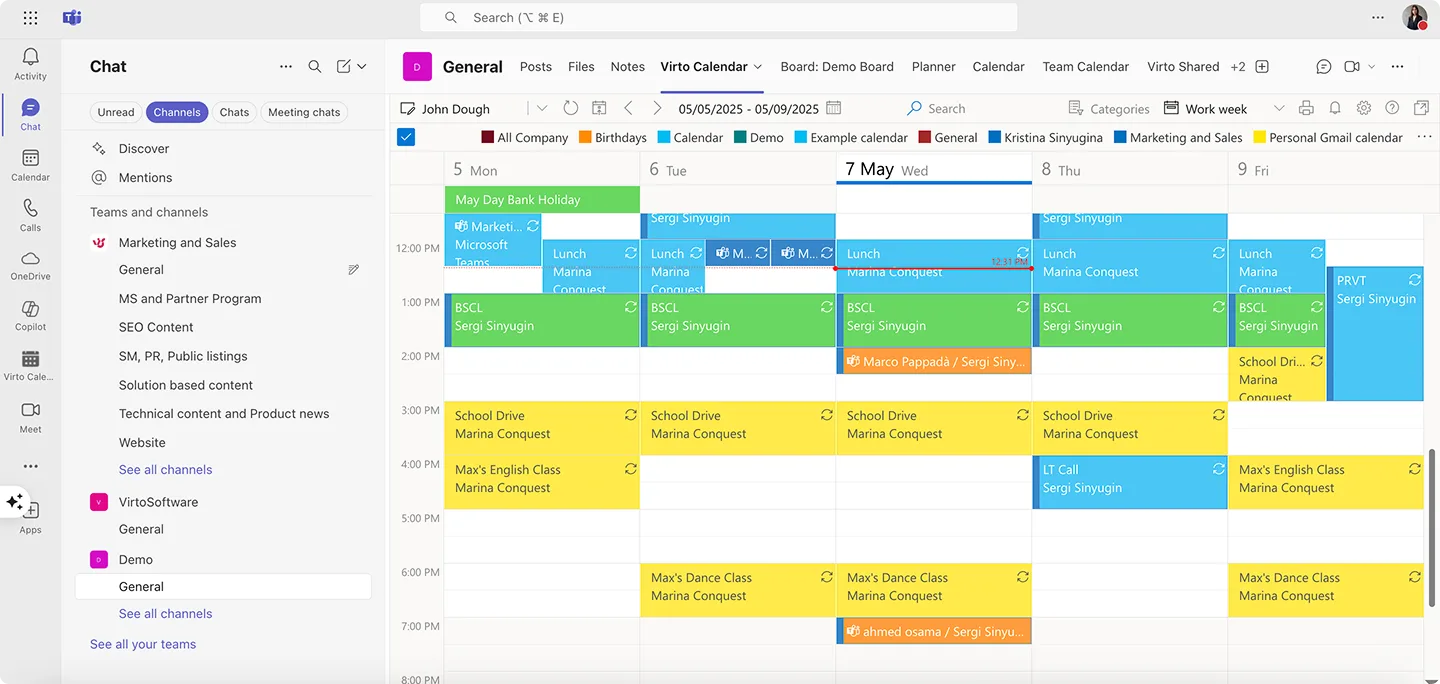
While the kanban board handles tactical task management, the Virto Calendar App provides strategic oversight for deadlines, resource allocation, and timeline coordination. This visual planning tool helps creative teams maintain control over the bigger picture while managing day-to-day execution details.
Campaign and release planning made visual
Creative work often revolves around fixed deadlines—campaign launches, publication schedules, event dates, client presentations—that can’t be moved. The calendar provides clear visibility into these critical dates while showing how current work progresses toward meeting them.
Teams can plan backwards from launch dates, identifying key milestones and dependencies that ensure on-time delivery. The visual timeline helps creative directors and project managers spot potential resource conflicts or unrealistic expectations before they become problems.
Comprehensive event and task management
The calendar supports detailed event creation with descriptions, attendee lists, reminders, and resource requirements. Recurring activities like weekly client check-ins, creative reviews, or sprint planning sessions can be automatically scheduled, reducing administrative overhead and ensuring consistent project rhythm.
Filtering capabilities allow teams to view calendars by project, team member, client, or task type. This flexibility proves especially valuable for agencies managing multiple clients simultaneously or internal teams balancing various campaign types and priorities.
Integration that eliminates duplicate work
Direct integration with Outlook and Teams calendars ensures information stays synchronized without manual updates. When project deadlines change or meetings get rescheduled, updates flow automatically between systems, preventing the confusion and missed deadlines that often result from managing separate calendar systems.
Powerful combination for complete project oversight
Used together, the Virto Kanban Board and Calendar create a comprehensive project management system that balances tactical execution with strategic planning. The kanban board shows what needs to happen today and this week, while the calendar provides context for how current work fits into longer-term objectives and deadlines.
Teams can embed both tools directly into Teams channels or SharePoint project sites, creating unified dashboards that give creative directors, account managers, and team members exactly the information they need without overwhelming complexity.
Virto Shared Calendar: Simplified scheduling for lighter needs
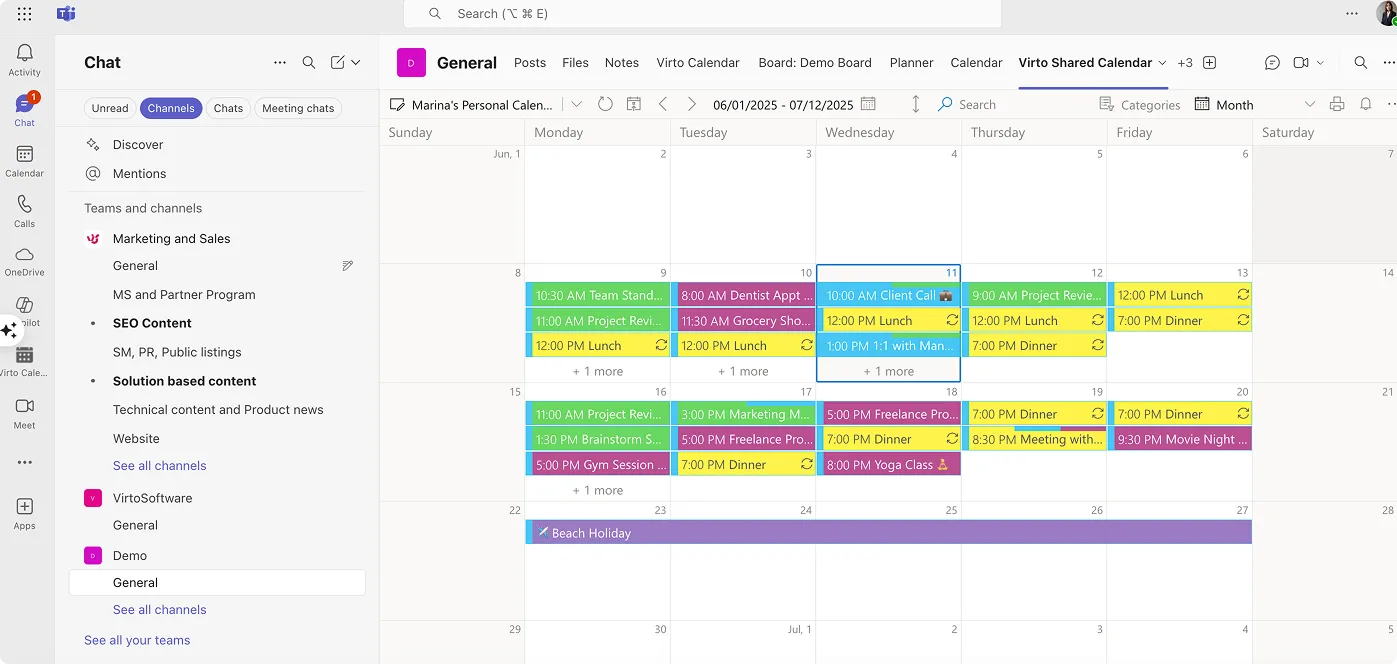
For teams requiring basic scheduling without the complexity of calendar overlays and integrations, Virto Shared Calendar offers a streamlined alternative. This lightweight solution focuses on event creation, tagging, and sharing—perfect for teams that need simple, visual scheduling tools.
Simple event management with powerful sharing
The shared calendar emphasizes ease of use with one-click event creation and color-coded tagging for instant categorization. Teams can organize events by project, client, priority, or any custom classification system that supports their workflow.
The standout feature is anonymous access capability, allowing teams to share calendars with external stakeholders—clients, vendors, freelancers—without requiring Microsoft accounts or complex permission management. This proves invaluable for client approval workflows, external vendor coordination, and stakeholder communication.
Cross-platform accessibility
Available both as a Teams app and standalone web application, the shared calendar ensures accessibility across devices and platforms. Changes made in Teams reflect instantly in the web app, maintaining synchronization without technical complexity.
Teams can embed the calendar directly in client-facing SharePoint sites or share web links for external visibility, making project timelines transparent to stakeholders without granting access to internal project management systems.
The integrated advantage
The Virto Kanban Board App, Virto Calendar App, and Virto Shared Calendar represent a well-thought-out, visually-oriented solution for creative project management that respects how creative teams actually work. These tools suit organizations ranging from small creative studios to large agency environments, offering quick implementation without extensive training requirements.
Most importantly, they reduce coordination overhead and task monitoring complexity, freeing creative professionals to focus on what they do best—creating remarkable work that connects with audiences and achieves business objectives. When project management feels invisible and supportive rather than bureaucratic and constraining, creative teams can achieve their full potential while still delivering predictable, professional results.
Check Our VirtoSoftware Project Management & Scheduling Use Cases
Conclusion on Project Management for Creative Teams
Creative projects demand a fundamentally different approach to management—one that embraces flexibility over rigid structure, prioritizes visual communication over detailed reports, and fosters collaboration rather than enforcing hierarchies. The iterative nature of creative work, the subjectivity of creative feedback, and the cross-functional collaboration required for successful campaigns all require management approaches that traditional project management simply wasn’t designed to handle.
The good news is that the right strategy and software can dramatically transform creative team performance. When teams implement thoughtful project management that supports rather than constrains their creative process, they experience fewer rounds of revisions, produce higher-quality creative output, and consistently meet critical deadlines. The chaos that often characterizes creative environments can be channeled into purposeful productivity without sacrificing the spontaneity and exploration that fuel great creative work.
For teams already working within the Microsoft 365 ecosystem, testing tools specifically optimized for this environment offers the path of least resistance toward better project management. Virto Kanban Board App, Virto Calendar App, and Virto Shared Calendar provide exactly the transparency, flexibility, and manageability that creative teams need—all while staying within the familiar collaboration environment they already use daily.
These tools eliminate the friction of switching between platforms, reduce the learning curve associated with new software adoption, and maintain the communication context that keeps creative teams aligned. Whether you’re managing design sprints, coordinating marketing campaigns, or planning content calendars, the visual and collaborative approach of these integrated solutions can help your team achieve the balance between creative freedom and professional delivery that defines successful creative project management.
Schedule a demo with our team to see how these tools can specifically support your creative workflows, or download free versions of each app directly from our website to start experimenting with your actual projects. There’s no better way to evaluate project management software than by using it with real creative work.
For additional insights into optimizing creative team productivity, explore these specialized resources on our blog:
The best creative project management happens when teams stop fighting their tools and start leveraging them. Make the shift from creative chaos to purposeful productivity—your projects, your team, and your clients will all benefit from the transformation.

